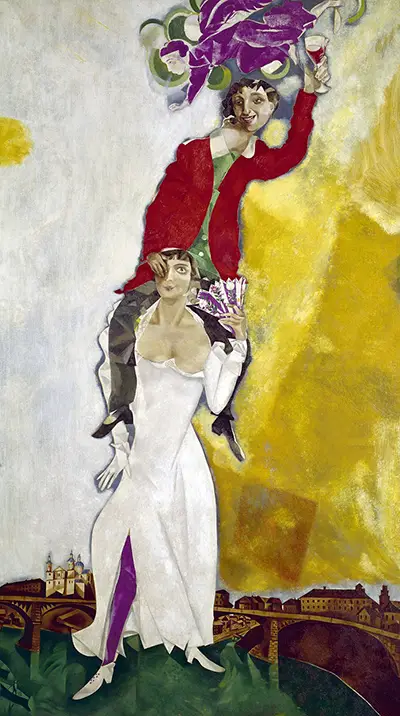The couple seems to be towering above the city of Vitebsk; Chagall's hometown and the place where he married her in 1915. The groom's joy is clear in his laugh and the way he raises his glass of wine in a toast. Bella, painted in a white dress, is also delighted with her eyes wide open with love and emotion and a wide smile lighting up her face. Wedding portraits are commonplace throughout history, but the Double Portrait with a Glass of Wine varies from the norm. Full of warm and bold colours, the painting uses the primitive or naïve technique to show Chagall's excitement for marriage, and the promising future him and his wife envisioned with each other. Yet this image of luminous joy was created in the first winter of the Russian Revolution, an event for which Chagall had conflicting emotions.
Like in most of his works made during this period, their nuptial bliss seems to have made them buoyant, keeping them soaring over the traumas of a troubled world. This is one of many wedding portraits that Chagall continued to make well after their wedding day. He seemed to have never come down from the excitement of that day, and most of the artworks depict him and his bride flying. He first pictured Bella flying in Birthday, a painting of the couple floating around their kitchen in a playful kiss. He would keep her above the chaos of the time in other work like The Promenade and Over the Town. It seems as though he could not believe he had pulled it off; marrying the person he had fallen in love with at first sight!
"...I had only to open my window, and blue air, love, and flowers entered with her. She seemed to float over my canvases, guiding my art... When you did catch a glimpse of his eyes, they were as blue as if they'd fallen straight out of the sky. They were strange eyes, long, almond-shaped and each seemed to sail along by itself, like a little boat..."
Double Portrait with a Glass of Wine has travelled the world, thrilling large audiences at major Chagall retrospectives in Japan, America and in the home country, Russia; both at Galerie Tretyakov Moscow and Musée National Russe in Saint-Petersburg. The painting is now one of the permanent collections of The National Museum of Modern Art in France. It was first exhibited in Paris at the Petit Palais in 1937. At this time, Marc Chagall and Bella had relocated to the city of romance, as if for their happy ever after.
